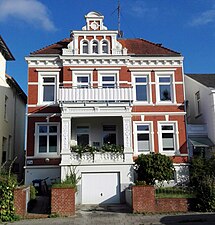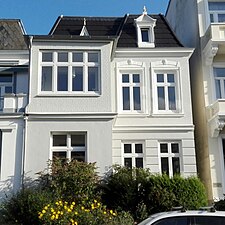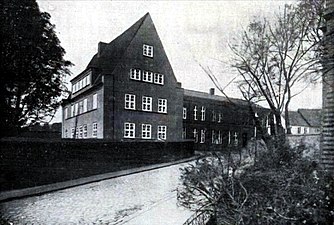August Heinrich Niebour
August Heinrich Niebour (born August 30, 1889 in Deichhorst near Delmenhorst , † October 6, 1929 in Lübeck ) was a German judge and senator of the Hanseatic city of Lübeck.
Life
origin
His grandfather, the Oldenburg lawyer Niebour , emerged as a "sharp" democrat in the 1848 revolution . Eduard Niebour , who later became the district judge in Lübeck and President of the Oldenburg Higher Regional Court , was educated in Switzerland for years so that, according to tradition, he would grow up in a republic .
This married Emma Julie Hermine , née Thyarks, (1863-1954). In addition to his daughter, Helene Adele Hermine (1895–1954) emerged from the marriage. The family internalized Edward's basic views that had been preserved at the Frauenfeld Cantonal School . After August's death, mother and daughter moved to Geniner Strasse 21a in 1930 . When her mother died, Helene moved to Charlottenstrasse 4 . Both were also buried in the senator's hereditary funeral.
career
Born the son of an Oldenburg judge, Niebour visited the Katharineum there when his father was transferred to the joint regional court of the Hanseatic city and the Principality of Lübeck . After using it in 1908 with the school leaving certificate left, he studied in Freiburg , Munich , Berlin and Kiel , where he passed his first legal test in October 1911, the law . After him, the appointed Senate to trainee .
After the August experience rushed to the flag , the non-commissioned officer , who was going to the First World War , was caught in French machine gun fire in one of the first skirmishes on the advance in 1914 . The right half of his face and shoulder were shot to pieces and Niebour was seriously wounded and was taken prisoner in France for over four years . A prominent scar remained on his face after the operation . Later he had to undergo several operations in Germany because his wound in the head festered and severe headaches that ended in mental depression . occurred as a result. Because of his language skills, he was used by the French as an interpreter . As this he acquired the knowledge of human nature that should come to equip him in his later professional work. He noticed that his fellow prisoners reacted with reluctance and defiance to the form of the orders given by the French . In response, the French tightened their orders and made the prisoners' situation worse. By studying the mutual psyche, Niebour was able to put the orders into words in such a way that they would not be tightened in the future.
After passing his second legal examination in November 1919, Niebour became an assessor , on May 15, 1920 he was appointed magistrate and moved to "Geniner Strasse 19" as a tenant to the magistrate Onne Seitz. Appointed district judge on May 1, 1922, he moved to "Geniner Strasse 21a". As such, he always acted in an exemplary, just judging and arbitrating manner, since he always regarded the "amicable settlement" as the primary goal of his judicial activity. His judgments were recognized and if he advised a comparison , his advice was followed.
Niebour acted in the spirit of his favorite philosopher Johann Gottlieb Fichte , according to which doing nothing is the greatest sin . Understanding philanthropy, on which sincerity and respect for his fellow men were based, formed a basic characteristic of his being. In politics, this also earned him recognition from his opponents.
In 1924 his sister, who began to work as a welfare worker in Lübeck , moved to "Kronsford Allee 26a" and Niebour to "Geniner Straße 35". In that house, which no longer exists, he had his first private telephone .
On April 27, 1925, three senators were elected to the Senate of the Hanseatic City of Lübeck. While the Senators Carl Heinsohn and Alfred Dreger were part-time, Niebour was supposed to be a full-time senator. He and his sister merged their homes and moved into "Geniner Strasse 35".
The legal as bourgeois Senate Member Chosen had his business room in the house of the tax authority , and the authority of Internal Administration , and at times the upper school board he was coordinate, in Fleischhauerstraße 18 against the tax office . He was soon elected chairman of the authorities. As deputy police chief, he was chairman of the judicial commission , the disciplinary court for civil servants and the administrative court , and he was also chairman of the military commission and the monument council .
As permanent commissioner of the Senate for negotiations with the citizenship and military commissioner , the understanding between the citizenship and the military was particularly important to him.
After his father died the previous year and his mother had broken up his household , she and his sister moved into the first floor of "Geniner Strasse 16". In the same year the senator became a board member of the Lübeck medical column in the regional association of the Red Cross .
- Geniner Street
Although Niebour himself was a member of a party, the DVP , he was not an outspoken party person and despised the "party-like stamping". His worldview was based on the observation of reality and life , free from anything doctrinal .
An excruciating pressure in the head robbed Niebour of sleep . When he was thirty-three, he took leave on the advice of his doctors. Travel was a distraction, but no improvement. The sleep deprivation made itself more and more noticeable and the bachelor tried to force the necessary relaxation with evening socializing .
Building authority
In June 1926, Niebour was also appointed chairman of the building authorities and chaired all departments. A busy internal service and lively intercourse between the authorities and the citizens left their mark. The growing tasks filled the limited workspaces with more and more workplaces. Finally, a larger extension at Mühlendamm 10 was added to the building conglomerate, which had already been converted several times . Its high brick gable dominated the group of buildings facing the mill pond and the wall. A stairwell , recognizable from the outside through a large group of windows, connects the old with the new building . Its main entrance was accentuated by a pillar- like column that was both a signpost and a lantern . Its interior was structured by clinker bricks painted by Ervin Bossányi . The brass handle of the main entrance, which was also on other doors of new urban buildings, depicts the Lübschen double-headed eagle in flight based on a model by Otto Mantzel . The key plate , as a product of the local arts and crafts , showed a white-red heart plate with the year of construction and the inscription: " Free and Hanseatic City of Lübeck "
Since the house contained many office rooms and a meeting room for the building authorities, Niebour moved his office in 1928 to the "new" building authority building.
In addition, the created painter in the three brick niches with arched statements on the main porch in Kaseintechnik a fresco . Three groups of figures were represented. In the middle, the master builder hands the golden key of the finished house to a couple approaching from the right and receives flowers from them in return. On the left is another house under construction, where excavators and masons are at work.
- "New" building of the building authority
Niebour made particular efforts to upgrade the roads . With a favorable settlement he ended the dispute with Prussia over the maintenance of the "Hamburger Landstrasse". The Schrangenprojekt he also performed successfully.
Missing
On October 5, 1929, under the leadership of President Richard Oemler, the 50th anniversary of the entry into force of the Reich Justice Acts on October 1, 1879 was celebrated in the regional court in Grosse Burgstrasse . After the celebrations were over, Niebour went into a hall with friends . He left it and went down Braunstrasse . From there he walked along the Untertrave to the swing bridge . From here he used to go over the Wall Peninsula, across the street, along the railroad yard, to the Puppenbrücke and then walk home at the moat over the ramparts . On the wall peninsula behind the shed at the memorial warehouse of the emergency community , Niebour was last seen by a security police officer (Green Police) at 4:40 a.m. He hadn't noticed anything unusual about Niebour.
Since Niebour was meticulous to ensure that his mother was informed of his whereabouts , even if he was only hours late, she knew in the morning that something was wrong. When the senator, a model of punctuality , was absent without excuse on Monday, he was officially missing and a missing person advertisement appeared in all the city's newspapers on the 8th.
The possibility that Niebour was visiting relatives in Hamburg or Hanover could soon be ruled out, since the officers at the platform barrier of the station had not seen him, who was noticeable by his scarred face.
The Green Police looked for him unsuccessfully. Boats searched the city moat and on the following day expanded the area around the Trave and the city moat behind the Wieland bridge.
Since it was clear to his mother that an accident had happened to her son, she authorized the publication of an obituary with a photo that appeared on October 9th .
The police unsuccessfully searched the surrounding woods with dogs . The more time went on and you couldn't even find your hat , the more it was assumed that Niebour had not died in the water, but had instead been the victim of a robbery . In his introductory speech at the beginning of the second Bundestag of the 162 Bund on the 12th in the Hindenburghaus, the second chairman, to whom he had always been a “loyal comrade”, remembered the riddle of Senator Niebour.
Ferryman Max Brümmer, ferry leaseholder of the Struck ferry, noticed something strange in the screw water of his ship when he set off on the ferry near the port office on October 15th. Since he had previously worked for the police, he knew Niebour personally, he recognized the body of the person missing since the 6th. Since no particular injuries were found on the dead person and his full wallet and his Commerz Bank check book were found, robbery was ruled out as the cause of death . It turned out that Niebour had had an accident in the Trave . Only the time difference on Niebour's golden pocket watch , which only stopped at around 7:30 a.m., could not be clarified.
As soon as the discovery became known , all public buildings raised their flags to half-mast .
burial
Since a large crowd was expected, tickets for the chapel in the Senate Chancellery were sold on the 16th .
Under the audible from the city, ringing of bells of all churches, was on October 18 in 1929 deep gray sky of the two trains is occurring medical column which met already at 9:30, Niebours coffin from the columbarium of Vorwerker cemetery in the chapel to the beginning at 10:00 am funeral service supported. The laid body was surrounded by council servants in traditional official costume with mourning - fluffed bicorns , while the column held the guard of honor .
His mother and sister, members of the Senate and the citizenry , countless delegations from authorities and cooperations , associations and Lübeck works , the Reichswehr and the Navy , from the other Hanseatic cities were Hamburg through its mayor Carl Wilhelm Petersen and Senator Arnold Nöldeke and Bremen represented by Senator Albert von Spreckelsen , President of the Higher Regional Court Wilhelm Kiesselbach , the Lübeck ambassador from Berlin , Building Director Hans Pieper , his predecessor Johannes Baltzer , building advisors , architects and others.
Cathedral pastor Erwin Schmidt, pastor of the family in the first pastoral care district , gave the commemorative speech . Towards the end he indicated that after the stroke six months ago, Niebour would have been marked by death and that he would have already thrown his shadows in advance.
A hundred of the Green Police had marched outside during the service . When the funeral procession stepped out the door, the Schutzmannkapelle (Blue Police) began to accompany it with the funeral march of Frédéric Chopin . On be in one of the trees of life framed Rondell between yew hedges that are available grave who spoke Domgeistliche Georg Schaade one last prayer . When lowering the coffin, the Green Police shot three volleys over the grave, whereupon the celebration with Ludwig Uhland's " I had a comrade " ended.
In conjunction with the building authorities, admirers decorated his grave with a memorial stone . Its simple shape of the cross and the writing plates, as well as the granite stone corresponded to the character of the deceased. Only the bare essentials were chosen as the inscription and the sign of the Iron Cross indicated his difficult war fate.
Today the grave site (14-1-Q-25/26) has been closed and reassigned.
literature
- Karl-Ernst Sinner: Tradition and Progress. Senate and Mayor of the Hanseatic City of Lübeck 1918-2007 , Volume 46 of Series B of the Publications on the History of the Hanseatic City of Lübeck published by the Archives of the Hanseatic City of Lübeck , Lübeck 2008, p. 180
- Hans Friedl: Niebour (family). In: New German Biography (NDB). Volume 19, Duncker & Humblot, Berlin 1999, ISBN 3-428-00200-8 , p. 217 ( digitized version ).
- Senator Niebour †. In: Vaterstädtische Blätter , year 1929/30, No. 2, edition of October 26, 1929, p. 5.
- Senator Niebour † In: Lübeckische Blätter , Vol. 71, No. 42, edition of October 20, 1929, pp. 706–707.
- Emil Ferdinand Fehling , Lübeckische Ratslinie , Lübeck 1925, No. 1044
Web links
Individual evidence
- ↑ Deichhorst is now a district of Delmenhorst.
- ↑ Chronicle. In: Vaterstädtische Blätter , year 1924/25, No. 17, edition of May 10, 1925, p. 68.
- ↑ The new building authority building. In: Vaterstädtische Blätter , year 1928/29, No. 5, edition of December 9, 1928, pp. 17-18.
- ↑ To the new construction of the building authority building. In: Vaterstädtische Blätter , year 1928/29, No. 10, edition of February 17, 1929, p. 39.
- ↑ 50 years of German law. In: Lübecker General-Anzeiger , Volume 48, No. 235, edition of October 8, 1929.
- ↑ Missing Senator Niebour. In: Lübecker General-Anzeiger , Volume 48, No. 235, edition of October 8, 1929.
- ^ The riddle of Senator Niebour. In: Lübecker General-Anzeiger , Volume 48, No. 236, edition of October 9, 1929.
- ↑ In vain search. In: Lübecker General-Anzeiger , Volume 48, No. 237, edition of October 10, 1929.
- ↑ The Search for Senator Niebour. In: Lübecker General-Anzeiger , Volume 48, No. 238, edition of October 11, 1929.
- ↑ Bundestag of the 162 federal government. In: Lübecker General-Anzeiger , Volume 48, No. 241, edition of October 15, 1929.
- ↑ Senator Niebour's body recovered. In: Lübeckische advertisements , Volume 179, No. 241, edition of October 15, 1929.
- ↑ Funeral service for Senator Niebour. In: Lübeckische advertisements , Volume 179, No. 244, edition of October 18, 1929.
- ↑ Funeral service for Senator Niebour. In: Lübecker General-Anzeiger , Volume 48, No. 245, edition of October 19, 1929.
- ^ Tomb for Senator Niebour. In: Vaterstädtische Blätter , year 1929/30, No. 12, edition of March 15, 1930, p. 46.
| personal data | |
|---|---|
| SURNAME | Niebour, August Heinrich |
| BRIEF DESCRIPTION | German judge and senator of the Hanseatic city of Lübeck |
| DATE OF BIRTH | August 30, 1889 |
| PLACE OF BIRTH | Deichhorst |
| DATE OF DEATH | October 6, 1929 |
| Place of death | Lübeck |








